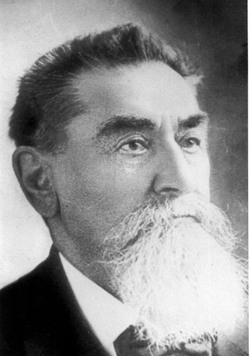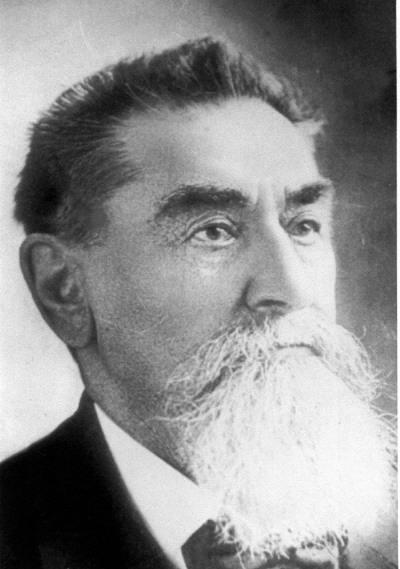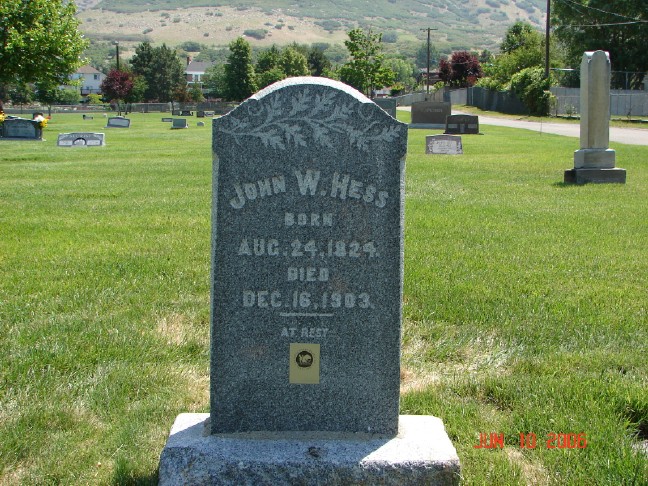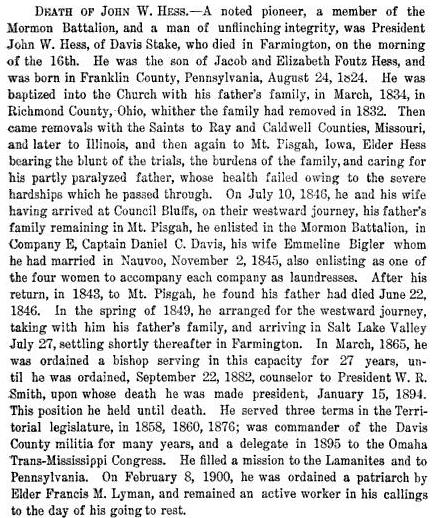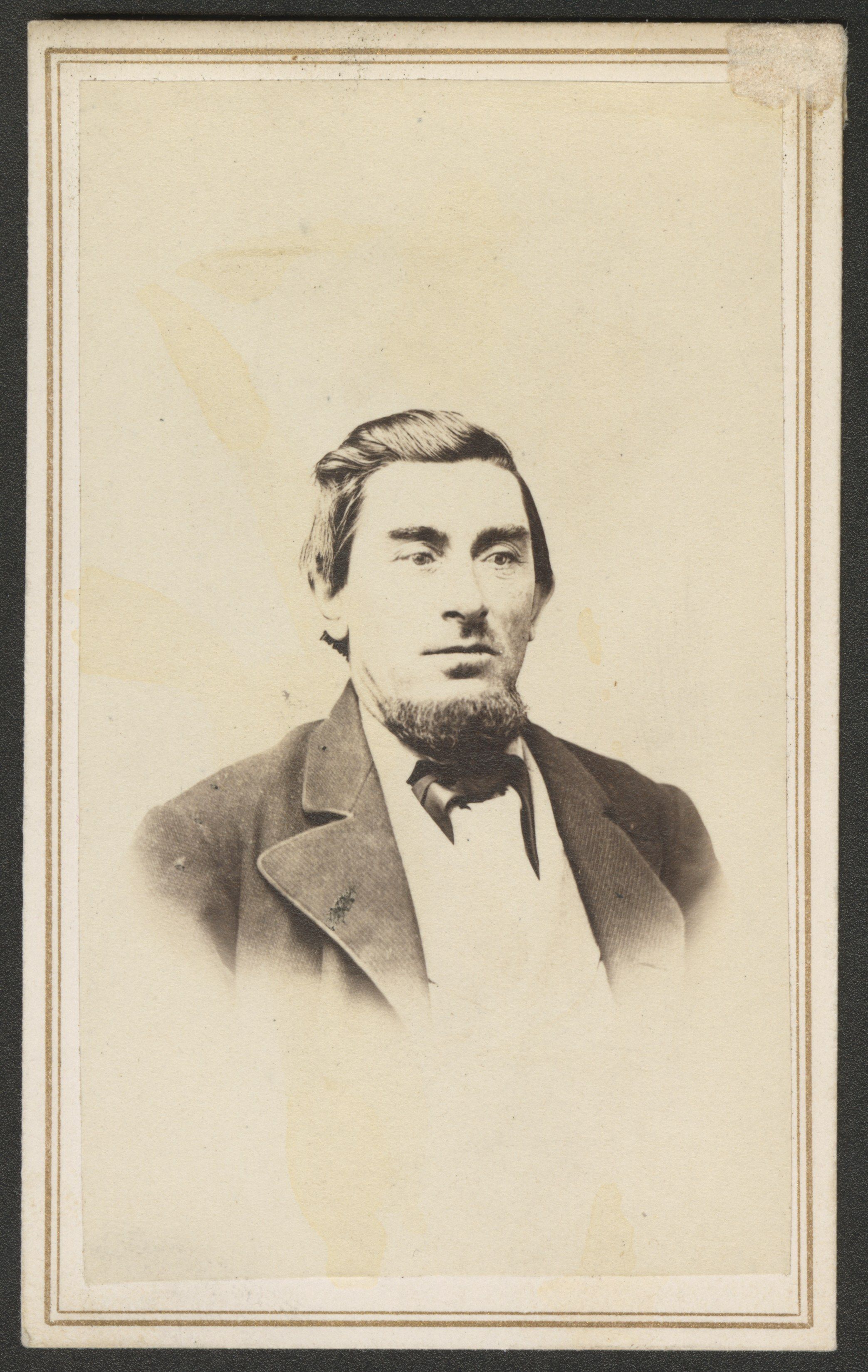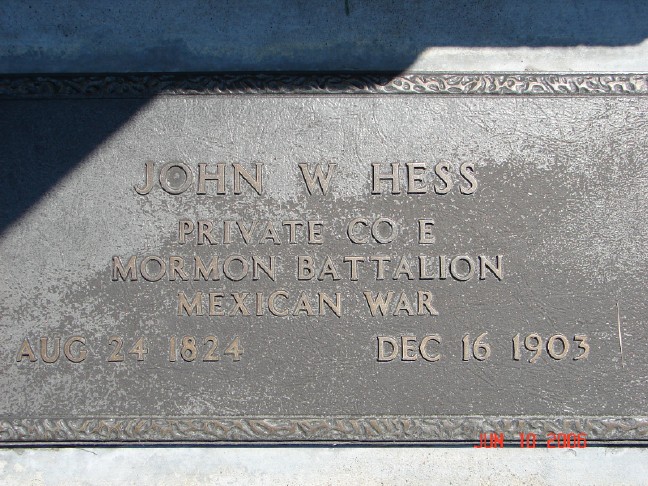Married Emeline Bigler, 2 Nov 1845, Nauvoo, Hancock, Illinois
Married Emily Card, 30 Mar 1852, Farmington, Davis, Utah
Married Helene Julia Petersen, 16 Nov 1856, Salt Lake City, Salt Lake, Utah
Married Mary Ann Steed, 27 Mar 1857, Salt Lake City, Salt Lake, Utah
Married Caroline K. Workman, 25 Apr 1862, Salt Lake City, Salt Lake, Utah
Married Sarah Lavina Miller, 30 May 1868, Salt Lake City, Salt Lake, Utah
Married Francis Marion Bigler, 28 Jul 1875, Salt Lake City, Salt Lake, Utah
IMPROVEMENT ERA VOL. V: 313 ~ DEATH OF JOHN W. HESS. A noted pioneer, a member of the Mormon Battalion, and a man of unflinching integrity was President John W. Hess, of Davis Stake, who died in Farmington, on the morning of the 16th. He was the son of Jacob and Elizabeth Foutz Hess and was born in Franklin County, Pennsylvania, August 24, 1824. He was baptized into the Church with his father's family, on March 1834, in Richland County, Ohio, whither the family had removed in 1832. Then came removals with the Saints to Ray and Caldwell Counties, Missouri, and later to Illinois, and then again to Mt. Pisgah, Iowa. Elder Hess bearing the brunt of the trials, the burdens of the family, and caring for his partially paralyzed father, whose health failed owning to the severe hardship which he passed through.
On July 10, 1846, he and his wife having arrived at Council Bluffs, on their westward journey, his father's family remaining at Mt. Pisgah, he enlisted in the Mormon Battalion, in Company E, Captain Daniel C. Davis, his wife Emeline Bigler whom he had married in Nauvoo, November 2, 1845, also enlisting as one of the four women to accompany each company as laundresses. After his return, in 1848, to Mt. Pisgah, he found his father had died June 22, 1846. In the spring of 1849, he arranged for the westward journey, taking him with his father's family, and arriving in Salt Lake Valley July 27, settling shortly thereafter in Farmington.
In March 1865, he was ordained a bishop serving in this capacity for 27 years, until he was ordained, September 22, 1882, counselor to President W. R. Smith, upon whose death he was made President, January 15, 1894. This position he held until his death. He served three terms in the Territorial legislature, in 1858, 1860, 1876; was a commander of the Davis County Militia for many years, and a delegate in 1895 to the Omaha Trans-Mississippi Congress. He filled a mission to the Lamanites and to Pennsylvania. On February 8, 1900, he was ordained a patriarch by Elder Francis M. Lyman and remained an active worker in his calling to the day of his going to rest.
Biography - Jacob Hess, John's father. was born in Franklin County, Pennsylvania on the 12th day of May 1792. In 1816 he married Elizabeth Foutz, who was born in the above state and county, June 4th, 1797.
The names of their children are as follows: Catherine Hess - Franklin, Pennsylvania Sept. 10, 1817; Polly Hess - Franklin, Pennsylvania June 27, 1819; Mary Ann Hess - Franklin, Pennsylvania August 11, 1821; John W Hess, Franklin, Pennsylvania August 24, 1824; Sarah Hess, Franklin, Pennsylvania Feb. 22, 1827; Anna Elizabeth Hess, Franklin, Pennsylvania March 24, 1829; Christena Hess, Franklin, Pennsylvania May 11, 1831; Harriet Hess, Richland, Ohio August 18, 1833; Lydiann Hess, Richland, Ohio July 24, 1835; David Hess, Ray County, Missouri February 18, 1837; Alma Hess, Ray County, Missouri June 3, 1839; Emma Hess, Adams County, Illinois May 17, 1841.
In 1832 Jacob Hess moved to Richland Ohio and located on a piece of heavy timberland, cleared a piece of ground and opened a small farm, and the prospects for a better living were quite flattering, considering the many difficulties consequent to a new country.
In March 1834, Jacob, Elizabeth, and four eldest children were baptized into the Church of Jesus Christ of Latter-day Saints. Previous to this they lived in peace with their neighbors, but soon after they were baptized their neighbors began to speak evil of and persecuted them in various ways.
About May 1, 1836, Jacob and his family moved to the state of Missouri and settled in Ray County of that state, near Pomerroy's Ferry or Richmond Landing on the Missouri River. There they lived on a farm which they rented from John Arbuckle, until the expulsion of the saints from Caldwell County, when they had to leave the state and went to Illinois and settled in Hancock County. There, Jacob again settled on a piece of wildland and in their extreme poverty they began to open a farm, and after much privation and toil succeeded in getting a comfortable home. The many years of labor and hardships that Jacob had passed through caused his health to fail and John W. was the only boy in the family, therefore, the greater part of the labor landed upon him.
In the meantime, John W. had purchased forty-acre of land for himself. They were putting up a long house, while the mobs were burning the saints' possessions in Morley's Settlement, near Lima in Hancock County, but they continued to labor until the violence of the mob was so great that they did not feel safe remaining on their farm longer. They then moved to the city of Nauvoo and occupied a part of the house belonging to Bishop Foutz, Elizabeth's brother. They left most of their supply on the farm at Bear Creek and before they had time to get them away, they had been destroyed by the mob. They were again left almost destitute.
In November 1845 Jacob was stricken with a shock of paralysis and lost the use of one side, which rendered him entirely helpless.
In the meantime, John W married Emeline Bigler (the first of seven wives). At this time the word went forth among the people that the church would leave Nauvoo in the spring. One may well imagine the situation they were in, to start on such a journey when they had been robbed of nearly all of their substance and the father was lying helpless in bed. The only alternative was to get away from the fury of the mob. They began to gather up what they had and commenced to get together an outfit. The best they could do was to rig up two old wagons and two yokes of oxen, one of which was John W's own property. John arranged one of the wagons with a bed of cord for his father to lie upon, as he could not sit up. It took one entire wagon for his convenience and then it was poor enough. This left one wagon to be drawn by one yoke of oxen to carry the outfit for the entire family - eight in number - while all the family had to walk every step of the way, rain or shine. Notwithstanding these difficulties, they fixed up the best they could and on April 3, 1846, they started, crossed the Mississippi River and camped on the Iowa side the first night, in a drenching rain.
April 4th they started on the wearisome journey, but with their heavy loads and the incessant rain that continued to fall, their progress was very slow. The best they could do was to travel from five to eight miles per day. As the father occupied one of the wagons, the rest of the family had no shelter, only what they could get by crawling under the wagons, and much of the time they were obligated to cut brush to lay on the ground to keep their beds out of water. Women and children walked through the mud, water, and wet grass. They waded through the streams so their clothing was never dry, for weeks and months, until they reached the place called Mount Pisgah, in the western part of Iowa. Here the advanced companies of the pioneers had planted corn and vegetables for the benefit of those who would come afterward. They stopped there for a time as their limited supplies were about exhausted and the father, Jacob, was so much worse, that it was impossible to move him any further, so they constructed a temporary shelter of bark which they peeled off from the elm trees that grew in the vicinity. This was about the 15th of June 1846.
Word had gone out that President Young would fit out a company to go to the Rocky Mountains that season to locate a settlement and put in grain the next season for the benefit of themselves and those that would come the following season.
Seeing that he could do nothing where he was, John W decided to take his own team and what he had, and go to Council Bluffs, 130 miles away, where the church authorities were then stopping. He made his father's family as comfortable as he could with the limited facilities he was in possession of, and took his wife and his own team and his little outfit, bade the rest of the family goodbye and started traveling in the Henry W. Miller Company. They arrived at Council Bluffs about the 10th of July and found that four companies had been enlisted and organized in the army, the Mormon Battalion. John W was advised by George A Smith and others to enlist and after considering the matter, he decided to do so. He was enlisted in Company "E". His wife Emeline, also enlisted as the government had provided for four women to each company of 100 men to go as laundresses.
John W left his team and wagon and little outfit with his brother-in-law, D. A. Miller, to be brought out the next year, as the government had provided two six-mule teams to each company. He was solicited to drive one team and for the comfort and convenience of John's wife, John consented to do so. Many times he was thankful that he had done so, as these teams had to haul the camp equipment which consisted of tents, tent poles, camp kettles, etc. which filled the wagons up to the bows, and the women would have to crawl in as best they could and lie in that position until they stopped for camp. As they had the management of loading, John could make the situation and comfort of his wife much better. For this and other reasons he did not mention, he was glad that he was a teamster.
About July 20th, they took up their line of march for Fort Leavenworth, Texas. About this time, John W heard of his father's death, which took place on June 22, 1846, at the place he had left him as he could not recover. John W was thankful to God that he had relieved his father, Jacob, of his sufferings, although it was a dark hour for his poor mother to be left in, such a desolate and sickly place without her natural protector, and with four small children with nothing to live on.
After being in the Mormon Battalion for about a year, John and his wife were discharged on Sept. 9, 1848, and they started back to Council Bluffs after his mother and her children (whom he had left at Pisgah) as they had no means to go further west. He arrived at Council Bluffs on Nov. 2, 1846, and rested a few days. They then continued his journey to Pisgah, one hundred and thirty miles, where he found his mother and her children all alive and well. It was a joyous meeting. He stopped with them a few days to arrange for the move in the spring and then went back to the Bluffs to try to get work for the winter. He was very short of means to accomplish such a great undertaking. He engaged to work for Apostle Orson Hyde for twenty dollars a month. He worked on month and then the weather got so severe that out-door work stopped. He was then out of employment for the rest of the winter.
In the spring he took all the means he had and bought a wagon and a yoke of oxen, hitched them up and went to Pisgah to bring his mother's family as far as the Bluffs, not knowing where the rest of his outfit would come from. Another kind providence came - when he got back he found the country swarming with emigrants on their way to the goldfields of California. On finding that, when he came over the road, they hired him for a guide, giving him a $200 cash advance. This was truly a blessing from the Lord that he had not thought of. He was now enabled to get the rest of his outfit.
On July 27, 1848, he arrived in the Salt Lake Valley having accomplished one more magnanimous act by bringing his dear mother and her four children to the home of the Saints. He found his dear wife, Emeline, well and with their first child in her arms, which had been born Jan. 6, 1848 while he was away. This was indeed a happy meeting, having been absent for eleven months. While he was away, the land he had the year before was given to other parties, so he went north to a place called Farmington and located.
Married Emeline Bigler, 2 Nov 1845, Nauvoo, Hancock, Illinois
Married Emily Card, 30 Mar 1852, Farmington, Davis, Utah
Married Helene Julia Petersen, 16 Nov 1856, Salt Lake City, Salt Lake, Utah
Married Mary Ann Steed, 27 Mar 1857, Salt Lake City, Salt Lake, Utah
Married Caroline K. Workman, 25 Apr 1862, Salt Lake City, Salt Lake, Utah
Married Sarah Lavina Miller, 30 May 1868, Salt Lake City, Salt Lake, Utah
Married Francis Marion Bigler, 28 Jul 1875, Salt Lake City, Salt Lake, Utah
IMPROVEMENT ERA VOL. V: 313 ~ DEATH OF JOHN W. HESS. A noted pioneer, a member of the Mormon Battalion, and a man of unflinching integrity was President John W. Hess, of Davis Stake, who died in Farmington, on the morning of the 16th. He was the son of Jacob and Elizabeth Foutz Hess and was born in Franklin County, Pennsylvania, August 24, 1824. He was baptized into the Church with his father's family, on March 1834, in Richland County, Ohio, whither the family had removed in 1832. Then came removals with the Saints to Ray and Caldwell Counties, Missouri, and later to Illinois, and then again to Mt. Pisgah, Iowa. Elder Hess bearing the brunt of the trials, the burdens of the family, and caring for his partially paralyzed father, whose health failed owning to the severe hardship which he passed through.
On July 10, 1846, he and his wife having arrived at Council Bluffs, on their westward journey, his father's family remaining at Mt. Pisgah, he enlisted in the Mormon Battalion, in Company E, Captain Daniel C. Davis, his wife Emeline Bigler whom he had married in Nauvoo, November 2, 1845, also enlisting as one of the four women to accompany each company as laundresses. After his return, in 1848, to Mt. Pisgah, he found his father had died June 22, 1846. In the spring of 1849, he arranged for the westward journey, taking him with his father's family, and arriving in Salt Lake Valley July 27, settling shortly thereafter in Farmington.
In March 1865, he was ordained a bishop serving in this capacity for 27 years, until he was ordained, September 22, 1882, counselor to President W. R. Smith, upon whose death he was made President, January 15, 1894. This position he held until his death. He served three terms in the Territorial legislature, in 1858, 1860, 1876; was a commander of the Davis County Militia for many years, and a delegate in 1895 to the Omaha Trans-Mississippi Congress. He filled a mission to the Lamanites and to Pennsylvania. On February 8, 1900, he was ordained a patriarch by Elder Francis M. Lyman and remained an active worker in his calling to the day of his going to rest.
Biography - Jacob Hess, John's father. was born in Franklin County, Pennsylvania on the 12th day of May 1792. In 1816 he married Elizabeth Foutz, who was born in the above state and county, June 4th, 1797.
The names of their children are as follows: Catherine Hess - Franklin, Pennsylvania Sept. 10, 1817; Polly Hess - Franklin, Pennsylvania June 27, 1819; Mary Ann Hess - Franklin, Pennsylvania August 11, 1821; John W Hess, Franklin, Pennsylvania August 24, 1824; Sarah Hess, Franklin, Pennsylvania Feb. 22, 1827; Anna Elizabeth Hess, Franklin, Pennsylvania March 24, 1829; Christena Hess, Franklin, Pennsylvania May 11, 1831; Harriet Hess, Richland, Ohio August 18, 1833; Lydiann Hess, Richland, Ohio July 24, 1835; David Hess, Ray County, Missouri February 18, 1837; Alma Hess, Ray County, Missouri June 3, 1839; Emma Hess, Adams County, Illinois May 17, 1841.
In 1832 Jacob Hess moved to Richland Ohio and located on a piece of heavy timberland, cleared a piece of ground and opened a small farm, and the prospects for a better living were quite flattering, considering the many difficulties consequent to a new country.
In March 1834, Jacob, Elizabeth, and four eldest children were baptized into the Church of Jesus Christ of Latter-day Saints. Previous to this they lived in peace with their neighbors, but soon after they were baptized their neighbors began to speak evil of and persecuted them in various ways.
About May 1, 1836, Jacob and his family moved to the state of Missouri and settled in Ray County of that state, near Pomerroy's Ferry or Richmond Landing on the Missouri River. There they lived on a farm which they rented from John Arbuckle, until the expulsion of the saints from Caldwell County, when they had to leave the state and went to Illinois and settled in Hancock County. There, Jacob again settled on a piece of wildland and in their extreme poverty they began to open a farm, and after much privation and toil succeeded in getting a comfortable home. The many years of labor and hardships that Jacob had passed through caused his health to fail and John W. was the only boy in the family, therefore, the greater part of the labor landed upon him.
In the meantime, John W. had purchased forty-acre of land for himself. They were putting up a long house, while the mobs were burning the saints' possessions in Morley's Settlement, near Lima in Hancock County, but they continued to labor until the violence of the mob was so great that they did not feel safe remaining on their farm longer. They then moved to the city of Nauvoo and occupied a part of the house belonging to Bishop Foutz, Elizabeth's brother. They left most of their supply on the farm at Bear Creek and before they had time to get them away, they had been destroyed by the mob. They were again left almost destitute.
In November 1845 Jacob was stricken with a shock of paralysis and lost the use of one side, which rendered him entirely helpless.
In the meantime, John W married Emeline Bigler (the first of seven wives). At this time the word went forth among the people that the church would leave Nauvoo in the spring. One may well imagine the situation they were in, to start on such a journey when they had been robbed of nearly all of their substance and the father was lying helpless in bed. The only alternative was to get away from the fury of the mob. They began to gather up what they had and commenced to get together an outfit. The best they could do was to rig up two old wagons and two yokes of oxen, one of which was John W's own property. John arranged one of the wagons with a bed of cord for his father to lie upon, as he could not sit up. It took one entire wagon for his convenience and then it was poor enough. This left one wagon to be drawn by one yoke of oxen to carry the outfit for the entire family - eight in number - while all the family had to walk every step of the way, rain or shine. Notwithstanding these difficulties, they fixed up the best they could and on April 3, 1846, they started, crossed the Mississippi River and camped on the Iowa side the first night, in a drenching rain.
April 4th they started on the wearisome journey, but with their heavy loads and the incessant rain that continued to fall, their progress was very slow. The best they could do was to travel from five to eight miles per day. As the father occupied one of the wagons, the rest of the family had no shelter, only what they could get by crawling under the wagons, and much of the time they were obligated to cut brush to lay on the ground to keep their beds out of water. Women and children walked through the mud, water, and wet grass. They waded through the streams so their clothing was never dry, for weeks and months, until they reached the place called Mount Pisgah, in the western part of Iowa. Here the advanced companies of the pioneers had planted corn and vegetables for the benefit of those who would come afterward. They stopped there for a time as their limited supplies were about exhausted and the father, Jacob, was so much worse, that it was impossible to move him any further, so they constructed a temporary shelter of bark which they peeled off from the elm trees that grew in the vicinity. This was about the 15th of June 1846.
Word had gone out that President Young would fit out a company to go to the Rocky Mountains that season to locate a settlement and put in grain the next season for the benefit of themselves and those that would come the following season.
Seeing that he could do nothing where he was, John W decided to take his own team and what he had, and go to Council Bluffs, 130 miles away, where the church authorities were then stopping. He made his father's family as comfortable as he could with the limited facilities he was in possession of, and took his wife and his own team and his little outfit, bade the rest of the family goodbye and started traveling in the Henry W. Miller Company. They arrived at Council Bluffs about the 10th of July and found that four companies had been enlisted and organized in the army, the Mormon Battalion. John W was advised by George A Smith and others to enlist and after considering the matter, he decided to do so. He was enlisted in Company "E". His wife Emeline, also enlisted as the government had provided for four women to each company of 100 men to go as laundresses.
John W left his team and wagon and little outfit with his brother-in-law, D. A. Miller, to be brought out the next year, as the government had provided two six-mule teams to each company. He was solicited to drive one team and for the comfort and convenience of John's wife, John consented to do so. Many times he was thankful that he had done so, as these teams had to haul the camp equipment which consisted of tents, tent poles, camp kettles, etc. which filled the wagons up to the bows, and the women would have to crawl in as best they could and lie in that position until they stopped for camp. As they had the management of loading, John could make the situation and comfort of his wife much better. For this and other reasons he did not mention, he was glad that he was a teamster.
About July 20th, they took up their line of march for Fort Leavenworth, Texas. About this time, John W heard of his father's death, which took place on June 22, 1846, at the place he had left him as he could not recover. John W was thankful to God that he had relieved his father, Jacob, of his sufferings, although it was a dark hour for his poor mother to be left in, such a desolate and sickly place without her natural protector, and with four small children with nothing to live on.
After being in the Mormon Battalion for about a year, John and his wife were discharged on Sept. 9, 1848, and they started back to Council Bluffs after his mother and her children (whom he had left at Pisgah) as they had no means to go further west. He arrived at Council Bluffs on Nov. 2, 1846, and rested a few days. They then continued his journey to Pisgah, one hundred and thirty miles, where he found his mother and her children all alive and well. It was a joyous meeting. He stopped with them a few days to arrange for the move in the spring and then went back to the Bluffs to try to get work for the winter. He was very short of means to accomplish such a great undertaking. He engaged to work for Apostle Orson Hyde for twenty dollars a month. He worked on month and then the weather got so severe that out-door work stopped. He was then out of employment for the rest of the winter.
In the spring he took all the means he had and bought a wagon and a yoke of oxen, hitched them up and went to Pisgah to bring his mother's family as far as the Bluffs, not knowing where the rest of his outfit would come from. Another kind providence came - when he got back he found the country swarming with emigrants on their way to the goldfields of California. On finding that, when he came over the road, they hired him for a guide, giving him a $200 cash advance. This was truly a blessing from the Lord that he had not thought of. He was now enabled to get the rest of his outfit.
On July 27, 1848, he arrived in the Salt Lake Valley having accomplished one more magnanimous act by bringing his dear mother and her four children to the home of the Saints. He found his dear wife, Emeline, well and with their first child in her arms, which had been born Jan. 6, 1848 while he was away. This was indeed a happy meeting, having been absent for eleven months. While he was away, the land he had the year before was given to other parties, so he went north to a place called Farmington and located.
Gravesite Details
Veteran
Family Members
-
![]()
Jacob Hess
1848–1937
-
![]()
John Henry Hess
1850–1923
-
Sarah Jane Hess
1852–1852
-
![]()
Hyrum Wilson Hess
1853–1922
-
![]()
Rheuamah Hess Ovard
1853–1924
-
![]()
Elzada Hess Sanders
1854–1926
-
![]()
Emily Rebecca Hess Udy
1854–1932
-
![]()
Moroni Hess
1855–1910
-
![]()
Harriet Sophronia Hess Earl
1857–1885
-
![]()
Jedediah Morgan Hess
1857–1938
-
![]()
James Henry Hess
1858–1931
-
![]()
Heber Chase Hess
1859–1886
-
![]()
William Alma Hess
1859–1934
-
![]()
Joseph Wells Hess
1859–1943
-
![]()
Mary Lovina Hess Moon
1861–1918
-
![]()
Albert Carrington Hess
1861–1937
-
![]()
Arthur Hess
1861–1951
-
Infant Hess
1862–1862
-
![]()
Madeline Udora "Dora" Hess Miller
1862–1895
-
![]()
George Albert Hess
1862–1947
-
![]()
Joseph Lancaster Hess
1864–1923
-
![]()
John Frederick Hess
1864–1948
-
![]()
Eliza Hess Wood
1865–1934
-
![]()
David Cornelius Hess
1865–1943
-
![]()
John W. Hess Jr
1867–1936
-
![]()
Wilford Woodruff Hess
1868–1917
-
![]()
Sarah Jane Hess Abbott
1869–1937
-
![]()
Emeline Rosalia Hess Bourne
1869–1942
-
![]()
Adeline Lovina Hess Udy
1869–1947
-
![]()
Mary Elizabeth Hess Smith
1870–1949
-
![]()
Caroline Rebecca Hess Moon
1872–1932
-
Frank Thomas Hess
1872–1959
-
![]()
Orson Pratt Hess
1873–1931
-
![]()
Alice Malinda Hess Pierson
1873–1941
-
![]()
Charles C. Hess
1874–1949
-
![]()
Josephine Archer Hess Mellus
1875–1960
-
![]()
Lot Hess
1876–1894
-
![]()
Lorenzo Snow Hess
1876–1905
-
![]()
Helen Louisa "Nelle" Hess Mellus
1878–1956
-
![]()
Caroline Hess Levedahl
1878–1959
-
![]()
Clarissa Natilia Hess Chipman
1879–1949
-
![]()
Horace Arnold Hess
1880–1949
-
![]()
Harriet Cordelia Hess Secrist
1881–1931
-
![]()
Mark Hess
1883–1944
-
![]()
Milton Miller Hess
1883–1966
-
![]()
Edward Hunter Hess
1884–1951
-
![]()
Hanna Lenore "Nora" Hess Butterfield
1885–1932
-
![]()
Amy Hess Sill
1885–1944
-
![]()
Andrew Hess
1887–1959
-
![]()
Jesse Eugene Hess
1890–1916
-
![]()
Florence Ireta Hess Bourne
1892–1957
-
![]()
Lucy Hess Neilson
1895–1975
-
![]()
Carl Bigler Hess
1899–1966
-
![]()
Lyman Minard Hess
1900–1957
Sponsored by Ancestry
Advertisement
Explore more
Sponsored by Ancestry
Advertisement
